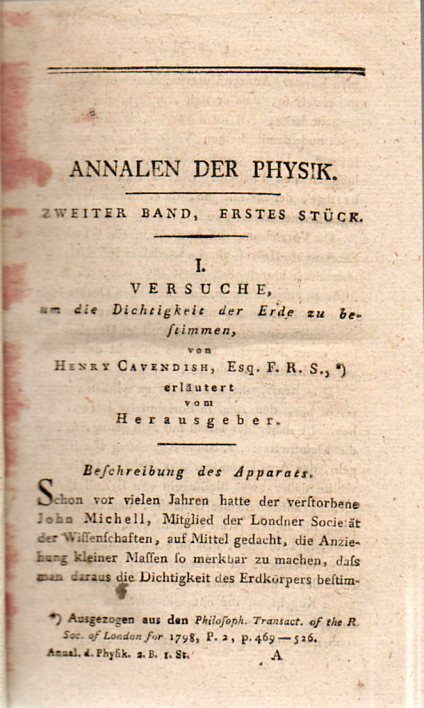Weighing the Earth in 1799
CAVENDISH, Henry. "Versuche über die Dichtigkeit der Erde zu Bestimmen." Halle, Rengerschen Buchhandlung, 1799, and published in Annalen der Physik, edited by Ludwig Wilhelm Gilbert, series I volume 2, 120pp in this section, 488pp overall in in the entire volume, with 9 plates. Cavendish's paper occupies pp 1-62, with two plates (with Michell's torsion balance being examined on one of the plates). First edition in German of this important paper.
Provenance: Ex-libris Deutsche Akademie der Luftfahrtforschung, then Wright Patterson Field Library (USAF), then Library of Congress. Library markings: small gilt-stamped "Akademie der Luftfahrtforschung", page edges stamped "Wright Field Library/Dayton, Ohio" on top and bottom. Contents quite nice. $450
In this experiment--the first appearance in German following the original paper "Experiments to determine the Density of the Earth" that appeared in the Philosophical Transactions in 1798.--the great and somewhat mysterious (and odd) Henry Cavendish determined to, of all things, weigh the Earth. Now there are certain remarkable things to be achieved in the 18th century, and of course the idea of measuring the weight of the Earth was a high intellectual achievement. He set off to measure the force of attraction between large and small lead balls using his dead friend John Michell's torsion balance (which he had created in 1783), and using of course Newton's laws showing that the force of gravity between two objects depends on their masses as well as the distance between them. Michell had thought of the experiment years before but died before he could present; Cavendish carried on and up, and out. Mind he wasn't the first on the spot, or the first with the idea--he was the first to complete it, though, taking the difference in the measures on the very sensitive balance from a distance using a telescope so as to not disturb the readings. It was a lovely idea, and a fantastic piece of work.
“Henry Cavendish had fitful habits of publication that did not at all reveal the universal scope of his natural philosophy. He wrote no books and fewer than twenty articles in a career of nearly fifty years. Only one major paper was theoretical, a study of electricity in 1771; the remainder of his major papers were carefully delimited experimental inquiries, the most important of which were those on pneumatic chemistry in 1766 and 1783–1788, on freezing temperatures in 1783–1788, and on the density of the earth in 1798.” (D.S.B. III, p. 155).





Comments